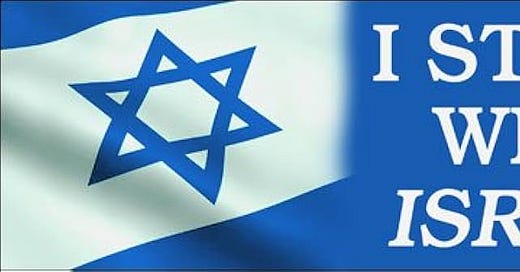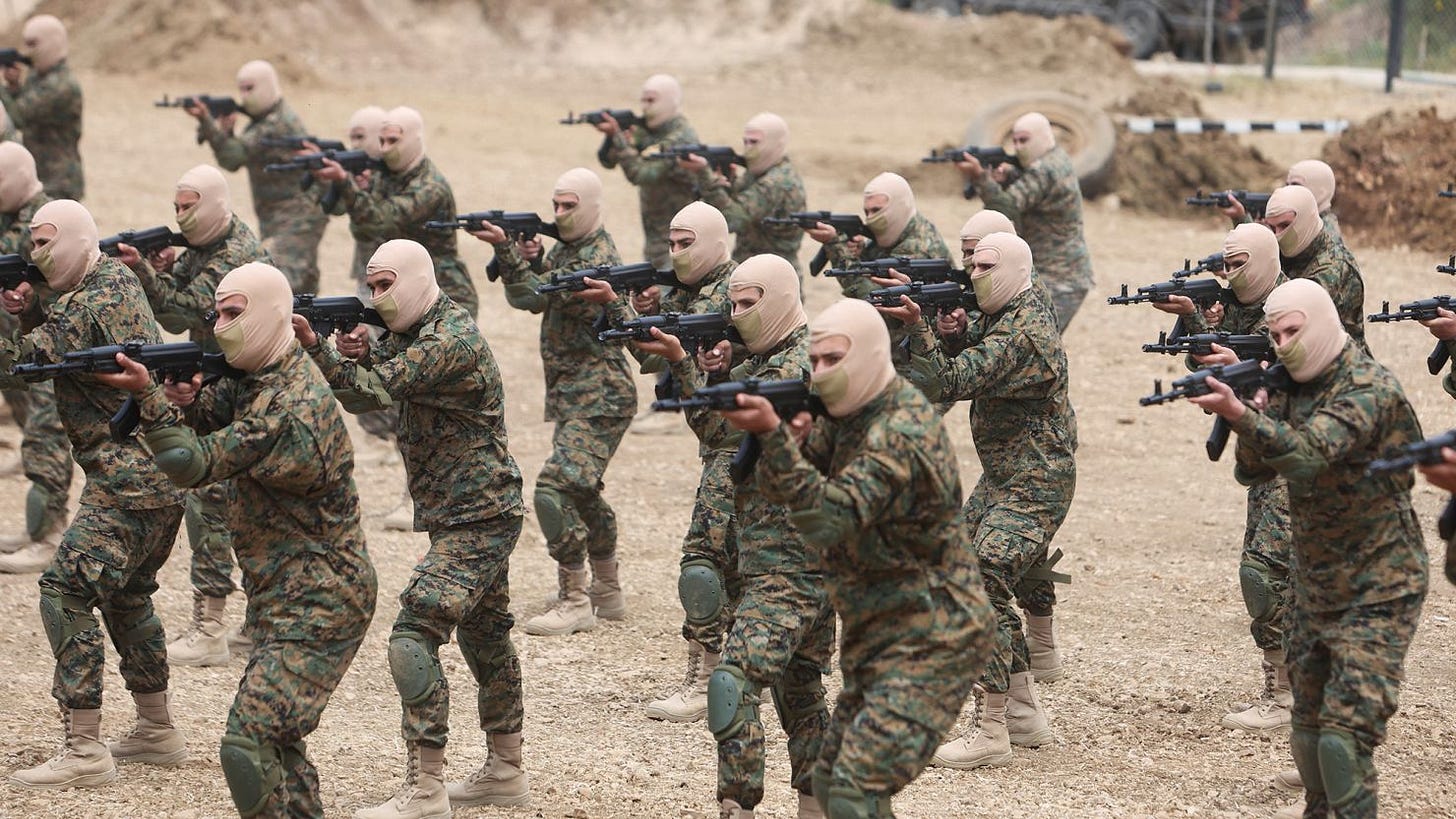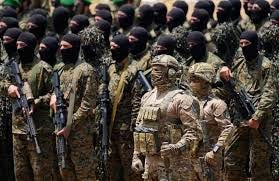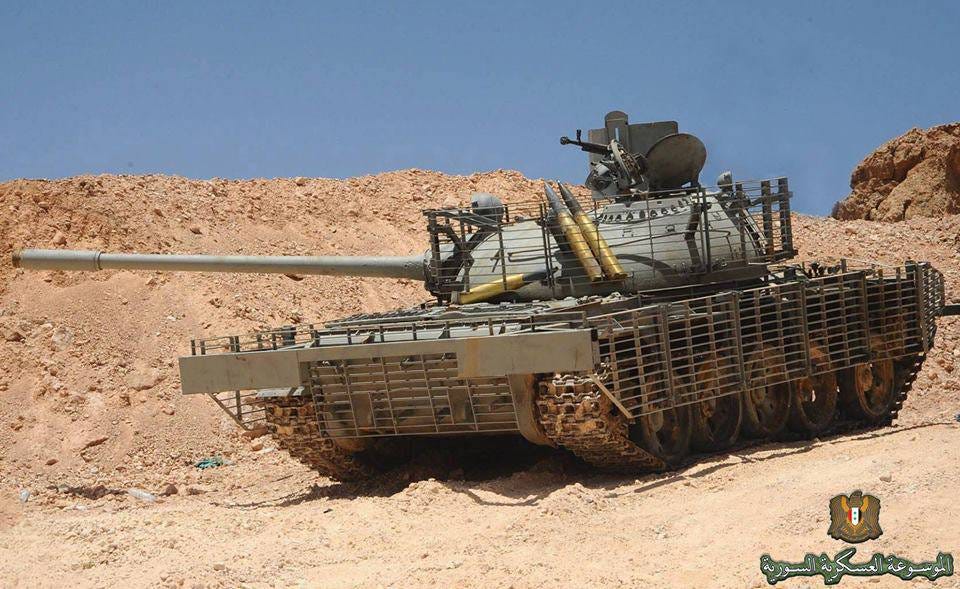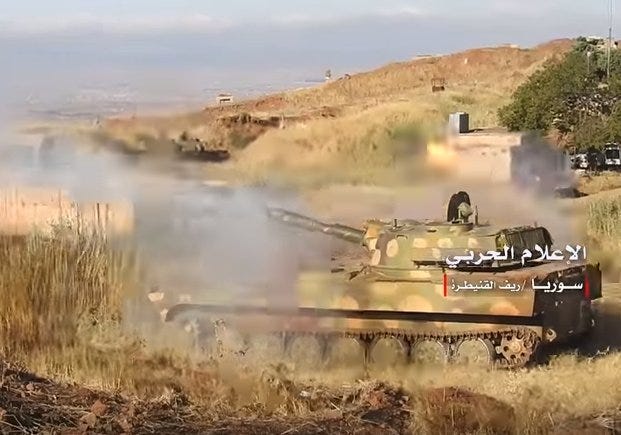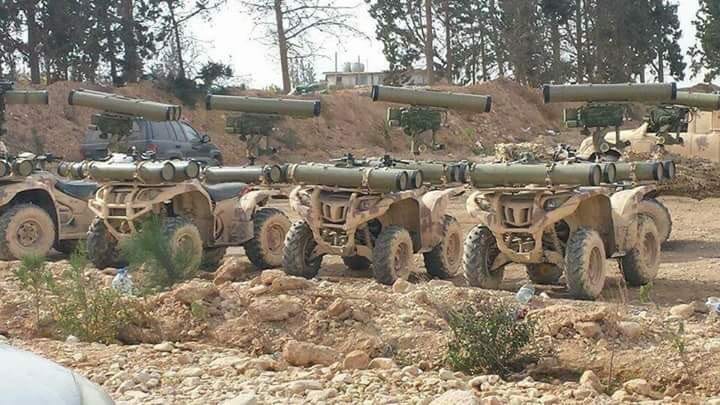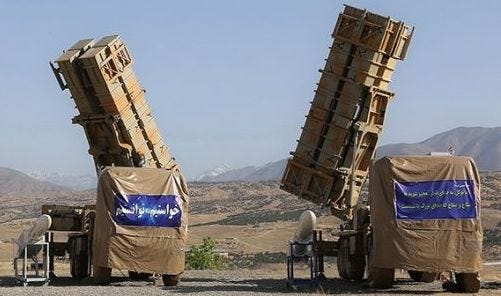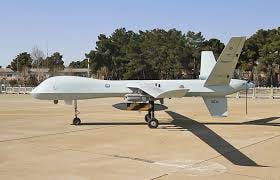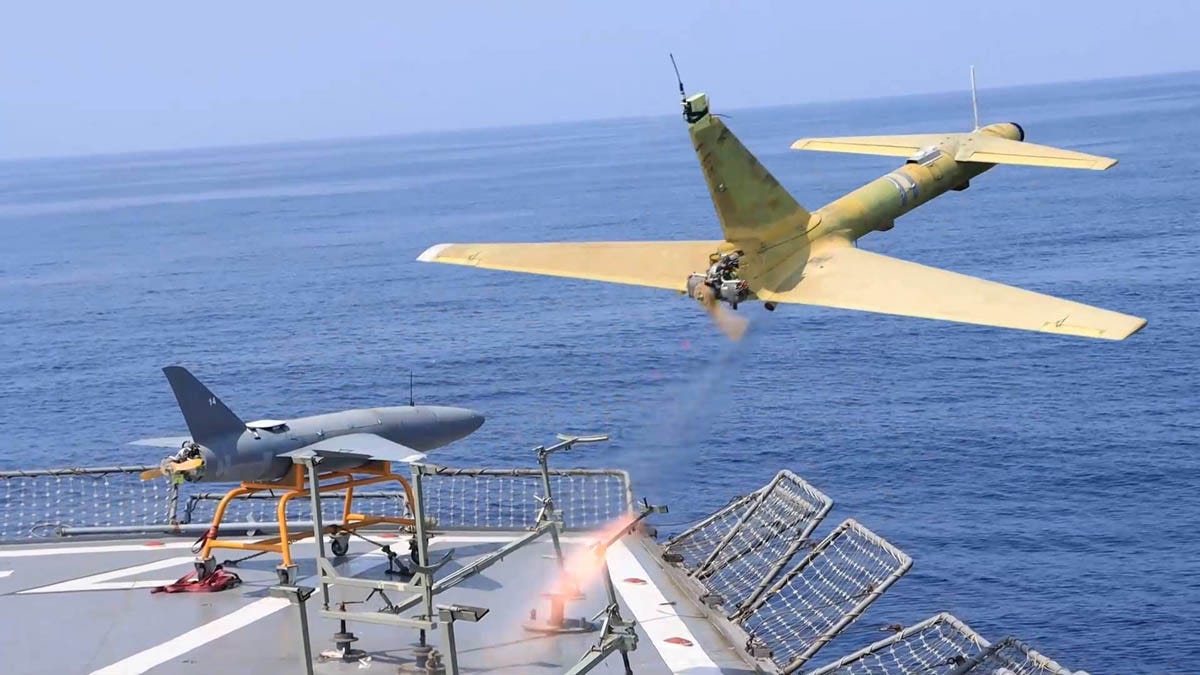Israel Versus Hezbollah Part II
Why a Israeli war against Hezbollah would be much different than the ongoing war against Hamas.
Before I went on vacation, I gave you a look at the long and bloody history of Hezbollah. Click the link below to read it.
This time I will look at what makes them a more dangerous foe in a battle against Israel.
The Current Situation in Israel
Shortly after Hamas’s brutal terrorist attacks in southern Israel on October 7, 2023, Israel was prepared to launch a preventive strike against Hezbollah forces in southern Lebanon. Israeli intelligence believed that Hezbollah fighters were on the verge of crossing the border into northern Israel as part of a multi-pronged attack. The IDF deployed fighter aircraft to their northern bases, and were awaiting orders to strike targets in Lebanon. On October 11, 2023 at 6:30 am, Israeli officials notified the White House that they were considering preventive strikes and requested US support. However senior US officials, pushed back, (not Biden, of course, because it was too early in the morning for him). They were skeptical of the Israeli intelligence regarding an imminent attack and worried that Israeli strikes in Lebanon would trigger an Iranian response and lead to a regional war.
Although Israel did not launch any strikes against Hezbollah, the possibility of an Israel-Hezbollah or even an Israel-Iran conflict looms over the region. Israel faces a dilemma, it can risk war with Hezbollah, a much larger, better armed and organized force than Hamas, and possibly draw Iran into the fray. They could also ignore the barrages of missiles hitting their country and not attack, but wouldn’t that could just be putting off the inevitable, as well as giving the advantage of surprise to Hezbollah? I believe that Iran and their proxies smell blood in the water. They see the anti-war/anti-Netanyahu protests in Israel, the ineffective American president, and the lack of concrete support from the US, and think now is the time for an attack that will rid the world once and for all, of the illegitimate state of Israel.
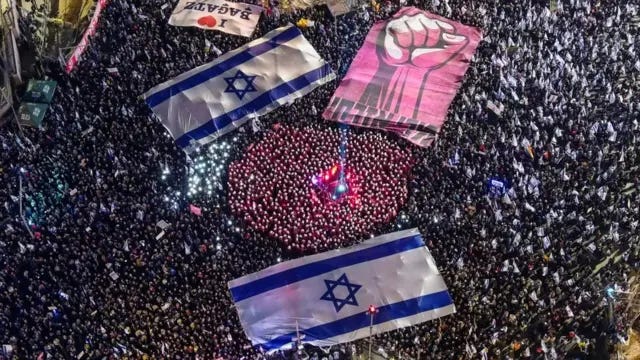
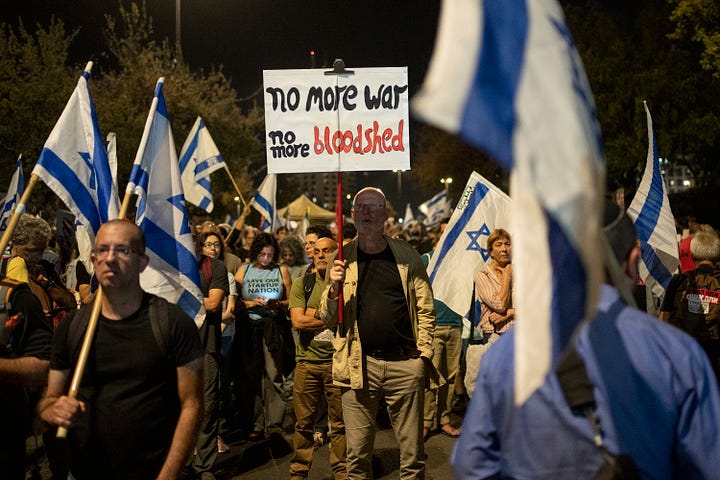
The current situation is delicate for several reasons. First, the October 7, attacks dramatically increased Israeli insecurity. It is difficult for most outsiders to fully comprehend the psychological impact and trauma caused by the gruesome attacks. Israel was surprised on October 6, 1973, when Egypt and Syria launched an attack on Israeli forces in the Sinai and Golan Heights, but October 7, 2024, was a surprise attack that killed Israeli civilians, including women, children, and the elderly, inside Israel. It involved numerous atrocities and sexual violence, much of it captured on video.
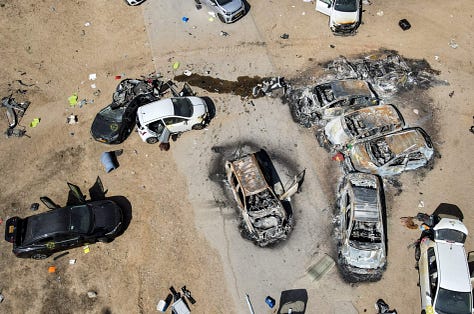
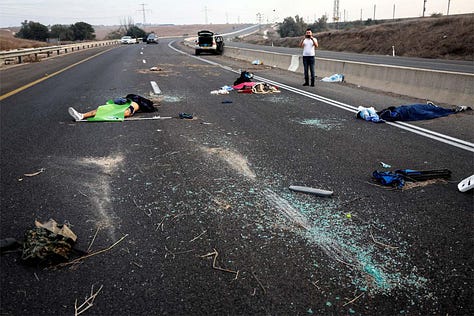
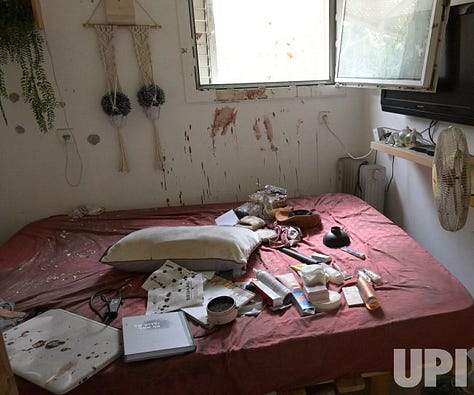
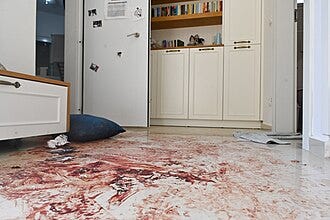

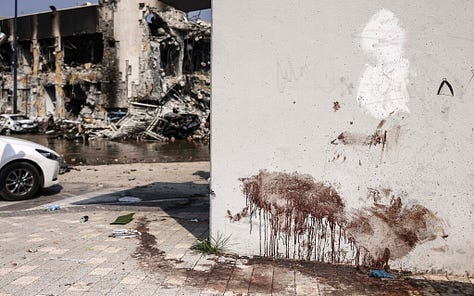
Indeed, it was the third-deadliest terrorist attack in the world, since data on attacks began to be collected in 1970. On a per capita basis, it was 15 times more deadly than the September 11, 2001, terrorist attacks in the United States. In interviews conducted in Israel in December 2023, Israelis of all sorts stressed the failure of their intelligence services and military forces on October 7, and many Israelis felt they could no longer rely on deterrence to stop Hamas or Hezbollah, given its failure. The attacks also took a psychological toll on Israelis. According to an analysis published in the medical journal The Lancet, the attacks led to notably higher levels of post-traumatic stress disorder (PTSD), depression, and generalized anxiety disorder (GAD) among Israeli citizens. It concluded, “Our findings show that the deleterious effects of these attacks were not restricted to those directly exposed to the brutal acts of terror but also to those indirectly exposed. Thus, these attacks are to be considered as a mass trauma event affecting an unprecedented proportion of the country’s population.” According to a Gallup opinion poll, Israelis’ emotional health plummeted after the attack, with record-high majorities saying they experienced higher-than-normal levels of worry (67 percent), stress (62 percent), and sadness (51 percent). As Gallup concluded, “No other country has ever seen such a large year-on-year increase in negative experiences.”
Consequently, Israel’s risk tolerance has likely changed. If Hamas, less well-armed and trained than Hezbollah, can brutally kill over 1,100 Israelis, what might the more formidable Hezbollah do? Hezbollah’s ties to Hamas and their even closer relationship with Iran reinforce this fear. Reducing the risk Hezbollah poses includes ensuring that Hezbollah’s elite Radwan forces are not poised on Israel’s border, as they were before October 7, 2023. Israel would also like curbs on Hezbollah’s arms and other, more expansive restrictions, though they are aware this is unlikely to happen. Israeli officials profess to prefer a diplomatic solution but warn that “we will have to act on our own should diplomacy fail”. Israelis are also very concerned about the apparent lack of real support coming from the United States. It seems that the Biden administration has adopted the Obama-era policy of complete capitulation to Iran and Iran is anti-Israel, so to maintain a good relationship with Tehran, Biden must do what no other American president since the founding of Israel has done, and hang them out to dry. Biden would rather kowtow to Tehran than help out only ally in the region and the Israeli public is worried that if they have to confront Hezbollah, they will be going it alone.
Second, in addition to increasing Israel’s sense of insecurity, the clashes between Hezbollah and Israel that have happened since October 7, have displaced more than 80,000 people in northern Israel. Hezbollah have launched 5,280 rocket, missile or done attacks into northern Israel since October 7. These attacks have caused wildfires to break out all over northern Israel burning more than 45,000 acres of Israeli territory and causing even more evacuation.
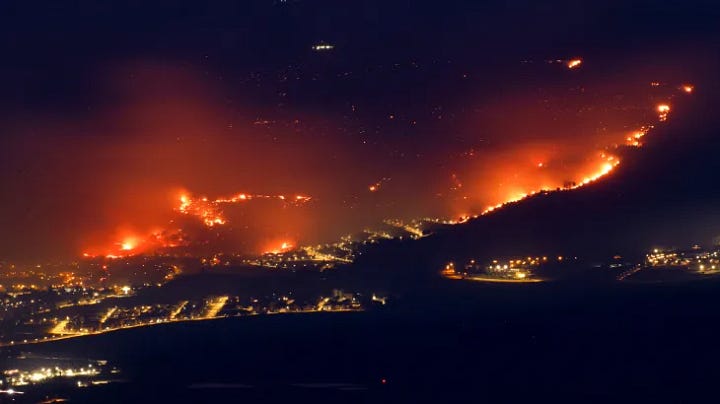
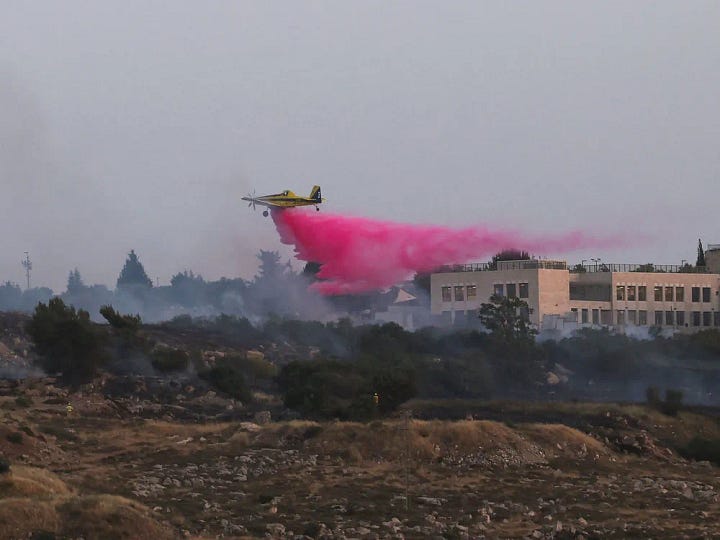
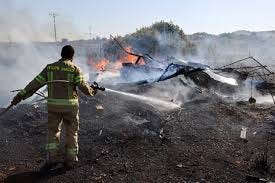
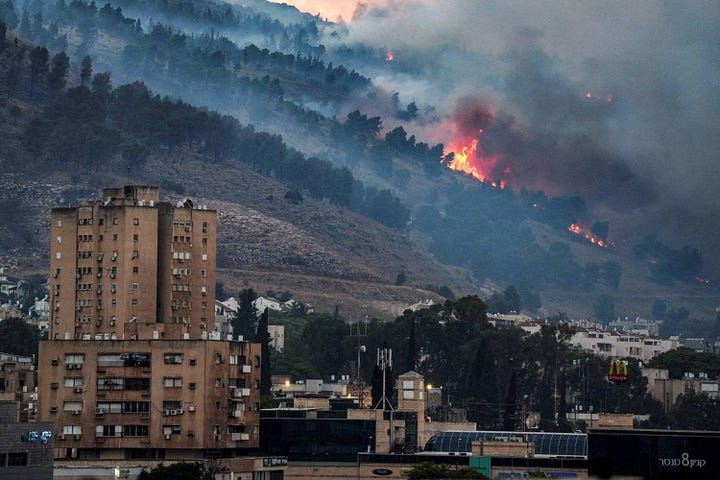
For Israel, resettling its internally displaced persons back to their homes and villages in northern Israel will require creating, and ensuring, a security environment that currently does not exist. Israeli leaders need to convince their population that, this time, the intelligence services can anticipate any attack and the military can stop it. A difficult task given Hezbollah’s capabilities and one far harder because of the military and intelligence failures of October 7. Domestic pressure has been growing to improve the security situation. According to Avigdor Liberman, a former minister of finance who leads one of the Israeli opposition parties, the Israeli government has been weak in the north: “The red line became a white flag, the war cabinet surrendered to Hezbollah and lost the North.”
Third, Hezbollah has dramatically improved its military since 2006 and stockpiled over 120,000 missiles and rockets in Lebanon and Syria. With Iranian proxy forces active in Lebanon, Syria, Iraq, and Yeman, the threat from the north could get worse over time, not better.
Fourth, Hezbollah has never lived up to its obligations as set out in UNSCR 1701. By stationing its forces in the zone between the Blue Line and the Litani River, sometimes under the cover of the fake nongovernmental organization “Green Without Borders”. Geolocated footage from Hezbollah propaganda videos indicates that Hezbollah ATGMs have struck Israeli forces from concealed launch sites less than three miles from the Blue Line on at least 17 occasions since October 7, a clear violation of UNSCR 1701. These attacks have mostly been against Israeli military bases, intelligence assets, surveillance sites, and reconnaissance units, however, seven Israeli civilians and ten IDF soldiers have been killed in the attacks.

Hezbollah has several objectives that could lead to a conflict with Israel, though the organization has numerous, and at times competing, goals, some of which would lead Hezbollah to be cautious. Hezbollah sees itself as a revolutionary organization, and one that is a leader in the broader Muslim struggle against Israel. They also see themselves as the defender of Lebanon, and territorial disputes and Israeli incursions are a constant source of tension. Finally, Hezbollah, like Hamas, seeks the release of prisoners in Israeli custody. Hezbollah, however, has reasons to be cautious. Most importantly, they seeks broader popularity in Lebanon, and triggering a destructive war could grievously undermine support, particularly outside its Shiite core constituency. Hezbollah also recognizes the military power of Israel and would not lightly provoke a conflict it might lose or, at the very least, lead to widespread destruction in Lebanon.
However, destroying Israel has been a part of Hezbollah’s core ideology since its founding, and most of its members are vehemently against the very existence of the Jewish state. Hezbollah shares this goal with Iran, which also rejects Israel and sees it as a threat to the Islamic Republic, which is why Iran put so much money into Hezbollah and why if the existence of Hezbollah is threatened by a war with Israel, Iran could step in to save their biggest non-state ally.
Hezbollah Military Capabilities
Hezbollah is the most heavily armed non-state group in the world, its forces primarily consist of light infantry, which have historically been trained and built for stealth, mobility, and autonomy. Hezbollah employs a version of what the United States calls “mission command,” empowering subordinates to make independent battlefield decisions based on a commander’s intent. This design has allowed Hezbollah to operate effectively under conditions of overwhelming Israeli firepower. In 2006, for example, its rocket units were designed to set up a launch site, fire, and disperse in less than 28 seconds, relying on prepositioned equipment, underground shelters, and mountain bikes to achieve such a small window of exposure. In the wake of the 2006 war, Hezbollah continued to build on the strengths of this approach, reorganizing and decentralizing its command and control, to force the IDF into more urbanized terrain where its fighters can take advantage of pre-staged, concealed and fortified positions. From a command and control perspective, Hezbollah has divided southern Lebanon into 75 self-sustaining zones connected together to act as a network. Which means it will be that much harder to defeat the group in Lebanon, since eliminating one zone doesn’t necessarily mean the collapse of another.
Hezbollah’s experience fighting in support of Bashar al-Assad in Syria for the past decade has given it access to capabilities and techniques used by conventional armies. Hezbollah can now conduct coordinated maneuvers of larger forces, employ suppressive artillery, and conduct logistics to support larger forces.
Human Assets
Hezbollah’s tactical proficiency, combat experience, and will to fight, make it a much deadlier threat than Hamas, and even national military forces in the region. Hezbollah was founded as a light infantry force and that remains their core, however they have been constantly upgrading their capabilities. In 2006, the CIA assessed Hezbollah's forces "to be amongst the most dedicated, motivated and highly trained non-state force in the world”. "Hezbollah fighters have been schooled from a young age to submit to strict military discipline and are nurtured in a culture of martyrdom, believing that God sanctions their struggles," adding that, "their military and ideological training is rigorous, and their operations in 2006 were marked by tactical agility, with effective command and control, and task organized forces, including an assault team, a breach element, and support team. Hezbollah was able to force Israel to withdraw from Lebanon in the 2006 war, and its forces have only grown more effective since then. Additionally, Hezbollah’s participation in Syria has given its troops real world experience in ground combat that few regional militaries possess. It taught them to learn how to conduct offensive operations and exposed them to the tactics, techniques, and procedures of the Russian military. The force of 30,000 active fighters and another 20,000 reserves have also repeatedly displayed a willingness to accept decisive engagement and fight to the last soldier, including suicide attacks. Attitudes that will only be increased by the desire to defend their homes from an Israeli offensive, regardless of the fact that any Israeli actions would have been provoked by Hezbollah itself. Hezbollah infantry units are equipped with the typical small arms; AK-47s, AK-74s, Iranian M-16 clones and the FN-FAL rifles. They use the Soviet-era PK, DShK and KPV machine guns and even the SVD Dragunov sniper rifle. Units are also equipped with 60, 81, 106, 120 and 160 mm mortars acquired from Iran or China.
Special Forces
Hezbollah began training special forces fighters in the 1990s, which are part of the Radwan Force, and number around 2,500 fighters. Originally known as the Rapid Intervention Force or the Intervention Unit, the unit was renamed in 2008 to honor Imad Mughniyeh who was also known as Hajj Radwan. The unit performs ambushes, assassinations, or operations that require deep infiltration. They are secretive but regarded as professional, able, and tough guerillas who excel in the art of operating clandestinely. According to Israeli Lieutenant Colonel Roni Amir, "On one occasion, when an Israeli Special ops team encountered a unit of the Radwan Force during a firefight, the Israelis thought at first that they had somehow become lost and were actually fighting a detachment of Israeli SEALs.
Subgroups of the Radwan Force include; Unit 1800, which provides training to militant groups in the West Bank and Gaza Strip (i.e. Hamas and the Palestinian Authority), Unit 910, which carries out "external operations" in Israel and abroad, and Unit 3800, which supports Iraqi Shiite militant groups, particularly in constructing IEDs. The Radwan Force have been heavily involved in the Syrian Civil War, gaining more experience and additional training from Russian military advisors.
Armored Units
Since Hezbollah began fighting in Syria they have added an unknown number of T-72, T-62 and T-55 tanks as well as some Soviet-era BMP-1 Infantry Fighting Vehicles to their table of organization. However, its ability to employ armor inside Lebanon is questionable. Tanks require a dedicated supply chain that may not exist in Hezbollah’s areas of control in Lebanon. Israel would also aggressively target any Hezbollah armor, with aircraft, artillery and even drones. Hezbollah also fought against a different enemy in Syria, irregular forces that look very different from the modern IDF. Hezbollah’s ability to employ the capabilities it has gained since 2006, in the face of IDF firepower, especially airpower, is also unclear, and indeed, it is likely that any large, heavy forces would be quickly destroyed if they were deployed.
Artillery
Hezbollah has also received towed and self-propelled artillery pieces from the Syrian government, including the 2S1 Gvozdika self-propelled 122 mm howitzer, the D-30 122 mm and the M-46 136 mm towed howitzers. However, as with the tanks, it will be a challenge for Hezbollah to use them in open combat against the IDF. Unless they come up with a new tactic for deployment of these pieces, at takes entirely too fire, then break down the howitzers, get them hooked to their trucks and move them. With the probable presence of high-altitude IDF drones covering most of the area of southern Lebanon, it is unlikely that Hezbollah would be able to fire and then move the artillery before a IDF air asset attacked them.
ATGMs
These weapons systems give Hezbollah potent capabilities to attack armored vehicles and fortified locations and make them more dangerous than the usual terrorist group. These capabilities were vital to its successes in the 2006 war, although Israeli tactical failures contributed to the loss rate it experienced among it’s armored units in 2006. I’m sure the IDF is unlikely to repeat those mistakes.
Hezbollah has improved its anti-tank capabilities since 2006, it currently fields the Tharallah ATGM system, a twin tube version of the Soviet AT-14 Spriggan ATGM. It is designed to overcome the active protection system used by the IDF’s Merkava main battle tanks (MBTs). They have also taken steps to improve the mobility of its anti-tank units, mounting AT-14 missiles on all-terrain vehicles. Several news outlets also reported in late January 2024 that Hezbollah had used a more advanced AT-14 EM to attack an Israeli air control base. This would represent a significant increase in ATGM range and destructive power. Analysis of Hezbollah’s combat performance in Syria suggests that their forces remain well schooled in using ATGMs against armored vehicles and fortified infantry positions. The result is that Hezbollah’s ATGMs are likely to remain one of its deadliest capabilities, even if they do not attain the success rate of 2006.
IEDs
Hezbollah also has a considerable Improvised Explosive Device (IED) capacity. Hezbollah employed IEDs with explosively formed penetrators (EFPs) against Israel in the 1990s and will seek to do so again. EFPs are shaped charges with a concave end, which typically send a molten copper slug through the armor of tanks, creating a deadly spray of hot metal and killing the crew. Hezbollah’s expertise in using IEDs allowed it to contribute to IED attacks against US and British forces in Iraq. During the war in Iraq, Iran’s Islamic Revolutionary Guard Corps–Quds Force, which aids Hezbollah, built infrared triggers, explosive circuits, and other EFP components in Iran and smuggled them across the border in Iraq to be used against US forces. Hezbollah could also conduct attacks on Israeli forces using tunnel bombs, which were used in Iraq and Syria to literally undermine fortified positions, or improvised rocket-assisted munitions. These IED capabilities, combined with Hezbollah’s ATGMs, would allow them to harass and disrupt the advance of Israeli ground forces in Lebanon.
However, ATGMs and IEDs will not be decisive in battle. They are suited for killing one vehicle at a time or striking a small, fortified position, not for defeating a combined force of infantry, armor, artillery, naval fire, and air power. Israeli countermeasures, such as the Trophy active protection system, will also limit their efficacy. (Trophy is a system that uses radar and high speed computers to continuously scan the area around a vehicle and when it senses an attack, launching EFPs of their own to destroy the incoming missile). IEDs will, however, inflict casualties, which Hezbollah leaders believe would undermine the political will for a long war in Israel.
Aircraft and Air Defense
Since the 2006 war, Hezbollah has emphasized the advancement and expansion of its air defense capabilities in an effort to degrade Israeli air superiority. Hezbollah’s air defenses include a range of systems primarily manufactured by Iran and Russia, including anti-aircraft guns, man-portable air defense systems, and short to medium-range surface-to-air missile (SAM) systems. These systems are most commonly smuggled through Syria into Lebanon, and in recent years, Hezbollah has occasionally used them to engage Israeli UASs flying over southern Lebanon.
In November 2023, US intelligence officials believed that Russia’s Wagner Group intended to transfer a SA-22 SAM system from Syria to Hezbollah. There have also been recent allegations that militias in Syria are actively training to use Iran’s most advanced air defense system, the Khordad-15. Israeli aerial activity has decreased in recent years and remains at historically low levels today, suggesting that Israel takes the threat of Hezbollah’s air defense systems to its aircraft seriously. Statements from Israeli military officials confirm as much. In 2022, the outgoing chief of Israel’s air force stated that Israel no longer had unimpeded air superiority over southern Lebanon.
In the event of war, Hezbollah’s air defenses would likely force Israeli aircraft to fly at higher altitudes, reducing their ability to accurately hit targets on the ground. At the same time, Hezbollah’s air defense systems would be high-priority targets for Israel. On February 26, 2024, the IDF announced that it had struck Hezbollah’s air defense sites in the Bekaa Valley in response to Hezbollah shooting down an Israeli drone over Lebanon earlier that day. In an escalated conflict, Israel would likely continue to favor the use of UASs over manned aircraft to reduce the risk to its pilots, though Israel does have fifth-generation aircraft such as the F-35 Lightning II stealth fighter. A successful downing by Hezbollah of a manned Israeli aircraft would be a strategically significant event and we have seen the lengths Israel will go to get one of her pilots back.
Although Hezbollah’s upgraded air defense systems pose a greater threat to Israeli aircraft than they did in previous conflicts, Israel still has immense air superiority over Lebanon. Israel’s air force boasts some of the most advanced aircraft in the world, including the US-built F-16, F-15, the aforementioned F-35 and the AH-64 Apache as well as homegrown systems like the Elbit Hermes 900 and IAI Eitan drones. Since the October 7, attack, Israel’s air force has successfully struck targets across Lebanon on a nearly daily basis.
Unmanned Aerial Systems
In addition to its rocket and missile stockpiles, Hezbollah possesses a significant arsenal of unmanned aerial systems (UASs) that include commercial quadcopters and suicide drones. Sophisticated platforms with surveillance and strike capabilities, like the Kaman-22, a copy of the US Predator drone, and the Ababil-2, as well as loitering munitions, (a kind of aerial weapon with a built-in warhead, that is designed to wait over an area until a target is located, then attack it, by crashing into it). Hezbollah’s UASs are almost entirely supplied by Iran and are currently used to conduct surveillance of, and strikes against, Israeli targets.
On January 25, 2024, the IDF struck a 4,000-foot runway in southern Lebanon that Hezbollah built with Iranian assistance and was used by Hezbollah to launch large UASs. The airstrip and the surrounding base illustrate the advancement of Hezbollah’s UAS capabilities to include larger and more sophisticated systems. The base also contained a helicopter landing pad, support and storage facilities, and warehouses and UAS hangers under construction. Since October 7, Hezbollah has attempted at least 40 UAS attacks against Israeli targets. Several of these attacks have successfully penetrated Israeli air defense systems, killing IDF soldiers and damaging military sites.
Rockets and Missiles
The bulk of Hezbollah’s arsenal consists of short-range unguided projectiles, like the BM-21 Grad, Fajr-3 and the Zelzal-2. Eliminating the threat from these rockets will be extremely difficult, the rockets can be launched from trucks, increasing their mobility, or bunkers, increasing their survivability, both of which were common during the last war. Since 2006, Hezbollah has also dramatically increased its numbers of long-range missiles, like the Fetah-110 and the Scud. Which means that most of Israel would be subject to Hezbollah long-range strikes against Israeli population centers. Hezbollah would do this to undermine Israeli support for the war. Finally, Hezbollah’s precision-guided missiles pose an acute threat to Israel’s most important political, military, and economic centers, including the nuclear reactor in Dimona, a threat that did not exist in 2006. Finding and destroying Hezbollah’s rocket and missile capabilities will be difficult and would involve an enormous effort involving a variety of intelligence assets, precision strike capabilities, and ground forces.
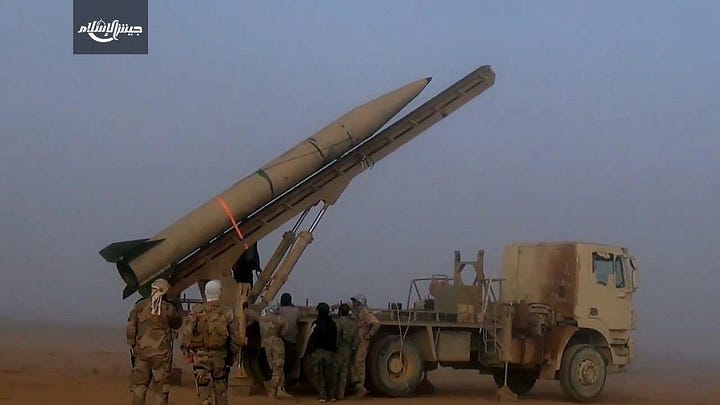

Hezbollah’s rockets and missiles pose two distinct threats to Israel. The first is their coercive effect: continuous rocket, missile, and drone barrages can kill or wound Israelis—both civilians and military personnel—or destroy important infrastructure in Israel. This is the way Hezbollah’s rockets and missiles were used in 2006 and how they will be used again if there is a war. The second threat comes from the operational effects of these weapons, suppressing IDF forces and limiting the effectiveness of Israeli operations. Hezbollah gained experience conducting combined arms (operations with infantry and artillery together), operations in Syria, and the group may attempt to use rockets and missiles as part of ground operations against Israeli forces. It is likely that Tehran would resupply Hezbollah quickly and this resupply is easier than in the past, as Iran’s presence in Syria has expanded considerably since the civil war began in 2011. Now, supplies from Iran can go through Iraq and Syria to Hezbollah in Lebanon. This stands in sharp contrast to Hamas, where weapons and people must be smuggled via tunnels into Gaza.
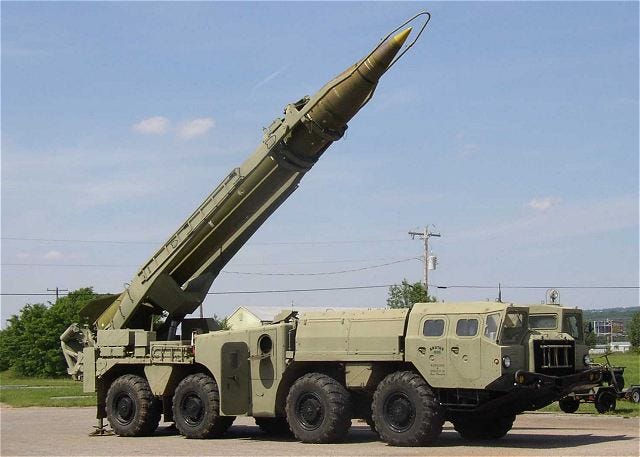
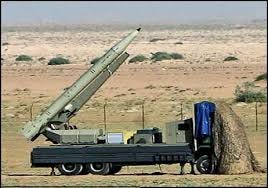
While Hezbollah has historically used its rockets and missiles to impose pain on Israel rather than as part of combined arms operations, an important unknown is how Hezbollah might use its rocket and (to a lesser extent) missile capabilities in support of ground operations against the IDF. They could attempt to capture territory in northern Israel or the Golan Heights, or at least conduct raids there. However, this would require Hezbollah forces to maneuver in the open, which for modern armies, usually means suppressive fire from artillery or air assets. Hezbollah demonstrated the ability to integrate ground maneuvers with suppressive fires in Syria, and it may attempt to do so in a war with Israel. However, such tactics are difficult in practice, and expertise is probably unevenly distributed across Hezbollah’s forces. IDF air defenses and air power would also limit Hezbollah’s ability to use its rockets and missiles in this manner.
Terrain Advantages
The geography of southern Lebanon offers several advantages for Hezbollah to exploit against Israel. The region, including much of the area directly across the Israeli border is predominantly rocky hills. In 2006 and other clashes with Israel, small and mobile groups of Hezbollah militants used the terrain to their advantage, concealing their movements to ambush Israeli units and fire rockets, as well as launching drones, and Anti Tank Guided Missiles (ATGMs) at Israeli positions on the border. Any heavy Israeli military ground force attempting to move throughout the region would likely be restricted to the major hard-packed roadways due to the hilly terrain and would, therefore, be vulnerable to harassment with ATGMs, IEDs and ambushes.
Hezbollah has built a network of tunnels and bunkers in the hills of southern Lebanon similar to the tunnels Hamas has used to great effectiveness against the IDF in Gaza. Hezbollah will use their tunnel network to hide and move equipment and personnel relatively securely as well as a base to launch ambushes and rocket attacks. Where it lacks military fortifications, Hezbollah fighters can exploit existing civilian infrastructure in the cities, towns, and villages throughout the region, just has Hamas has done. During the 2006 war, civilian infrastructure was critical to Hezbollah fighters in southern Lebanon. They used it in place of formal military fortifications to hide command centers, complicate Israeli targeting, conceal fighters for ambushes, and enable fighters to disperse, maneuver, and defend in depth. Thousands of civilians fled from southern Lebanon as strikes between Hezbollah and Israel intensified after October 7, 2023. Some of the towns and villages along Lebanon’s southern border almost completely emptied. In a war with Israel, Hezbollah would exploit civilian infrastructure in conjunction with its network of tunnels and bunkers to attack Israeli ground forces and quickly retreat.
In short, the Hezbollah that Israel would face if the present situation were to escalate to major ground operations, is more capable than it was in 2006. Hezbollah is larger, better armed, and more experienced, thanks in part to its experience fighting in Syria. It is most effectively designed to fight a coercive campaign aimed at killing Israeli soldiers and civilians at a steady rate through rocket, long-range missiles, ATGM, and UAS attacks. But it may also have some ability to conduct combined arms offensives against Israeli troops and limit Israeli air dominance. Even so, it remains technologically outmatched by the IDF, which has long prepared for a rematch of the 2006 war, and has been engaged in a war with Hamas since October 2023.
Next week I will go over the possible Israeli plans and the Hezbollah responses, as well as the possibility of Iran entering into a direct conflict with Israel if Hezbollah is attacked. I hope you find these post informative. Please feel free to pass them along to anyone who might be interested.
Chris

